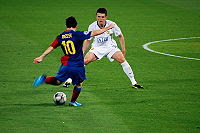INFORMATION ON NIKE WARM UPS
Total 90 Nike warmups are the best training suits made by Nike. If you select the correct size then it will be a very nice and snug fit of both the jacket and pants.
There is no collar to deal with on the soccer warmups and the shoulder and arm lengths feel just right.
This warmup is made with the light weight polyester that most all soccer warm ups are now made with.
The pants, which comes in black only, like so many classic nike warmups, is tapered down to the zippered ankles.
The Nike Total 90 warmups comes in the standard five colors of; red, royal, navy, forest, and black.
My recommendation for the best Nike warmups is the Nike Total 90 Team soccer warmups.
One of the best places to check for availability and sizing on Nike warmups is at...
If you prefer to have a collar on your Nike warmups, then your best choice will be the Nike Knit Jacket & Pants.
This is soccer warmup is much heavier than the standard soccer warm ups found in soccer retail because of the amount of cotton knitted in.
The Nike Knit warmups are a little bit larger in size than the Total 90 warmups with extra room in the shoulders and arms.
The collar on the Nike Knit jacket is a little flimsy and doesn't hold up very well if you zip it all the way up in cold and windy weather. The ribbed collar will stretch out easily. It does however lay down flat very nicely if the zip is down to where it's shown in the picture above.
The Nike knit pants are a good selection and comes in the same colors thats available in the jacket; black, forest, maroon, navy, purple, red, and royal. This will make this Nike warmup a popular training suit for teams.
The Nike Womens Unified Knit Jacket and Pant is of a similar quality to the Nike Knit warmups.
The arm length is a little long but the rest of the measurements are fitted for women.

























.jpg)
.jpg)










